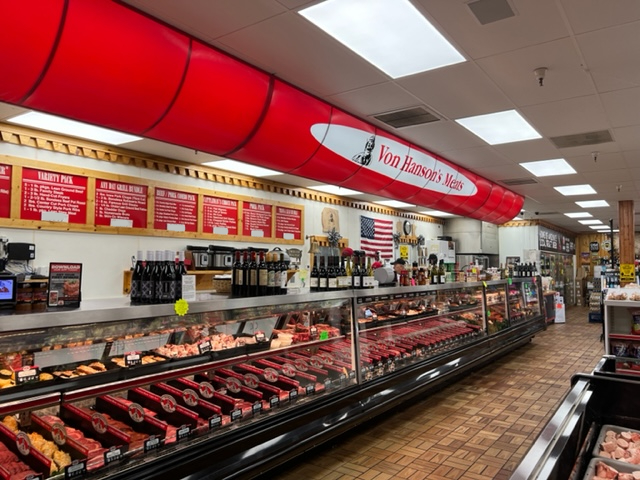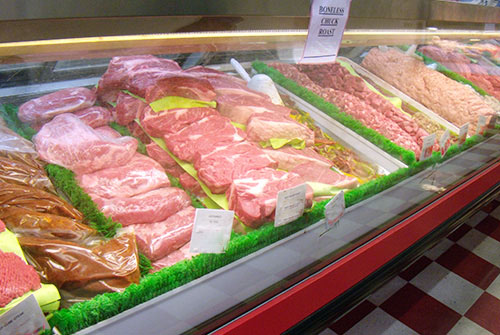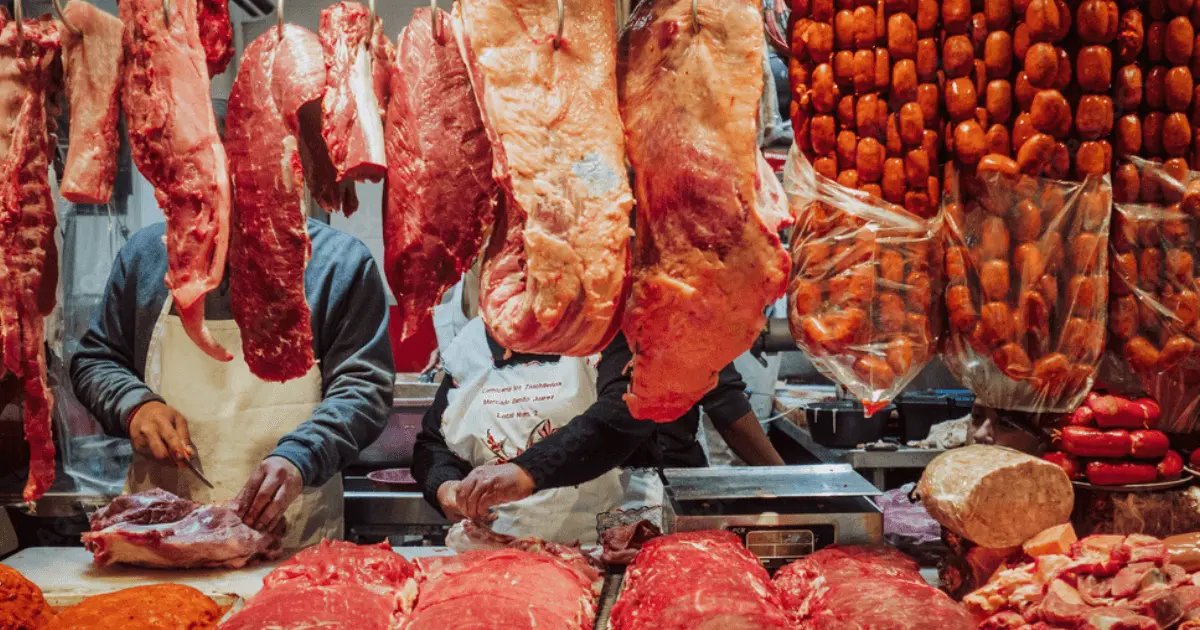Discover Fresh Cuts at Bagley Farms Meat Market Edwardsville IL for Your Next barbeque
Discover Fresh Cuts at Bagley Farms Meat Market Edwardsville IL for Your Next barbeque
Blog Article
Discover the Art of the Butcher's Cut in a Modern Meat Market
In the ever-evolving landscape of contemporary meat markets, the butcher's cut has transcended its conventional roots, combining olden craftsmanship with contemporary techniques. bagley farms meat market edwardsville il. Today's butchers are not just processors of meat; they are well-informed artisans that highlight sustainability and ethical sourcing. Their competence in picking and preparing cuts tailored to details cooking needs offers an exceptional dining experience. Yet, what truly establishes the contemporary butcher apart is their ability to build a deeper link in between consumers and the beginnings of their meat. How do these masters equilibrium custom with innovation, and what effects does this have for the future of meat usage?
Evolution of Butchery Strategies

The mid-20th century saw butchery techniques further improved by clinical insights into muscle biology and meat aging, enhancing both tenderness and preference. Innovations like vacuum packaging and refrigeration prolonged product shelf-life, allowing butchers to diversify offerings and enhance top quality control. This period likewise marked the surge of customized devices, such as band saws and meat slicers, which enhanced precision and performance in meat processing.
Electronic systems currently help in monitoring animal provenance and maximizing cuts to meet certain customer preferences. In addition, a revival in artisanal butchery has actually emerged, mixing conventional abilities with contemporary expertise to cater to customers seeking honest and sustainable meat alternatives.

Recognizing Meat Cuts

Comprehending the complexities of meat cuts is vital for both butchers and consumers seeking high quality and value. Each cut comes from a different component of the pet, imparting unique flavors, textures, and cooking approaches. Proficiency of these distinctions not only enhances culinary experiences but additionally optimizes the energy of each carcass. For butchers, accurate cuts show skill and regard for the craft, guaranteeing very little waste and optimal return.
The key groups of meat cuts consist of primal, sub-primal, and retail cuts. Primitive cuts, such as the loin, rib, and chuck, are the big sections originally separated from the carcass. Butchers then damage these down additionally into sub-primal cuts, prior to finally generating retail cuts offered to consumers, like ribeye or tenderloin. Each phase calls for mindful attention to anatomical structure and muscular tissue structure.
Comprehending muscular tissue composition is crucial; muscle mass made use of much more often by the pet tend to be tougher and are best matched for slow-moving cooking techniques, while less-used muscular tissues, like those found in the loin, are much more tender and perfect for grilling or roasting. Experience with these differences encourages consumers to make enlightened choices, boosting their culinary endeavors.
Choosing Top Quality Meat
Picking the best meat includes more than just picking a visually attractive item from the display screen. The art of selecting high quality meat needs a discerning eye and understanding of certain features that signify quality and quality. Firstly, focus on the shade; beef needs to have a bright, cherry-red shade, while lamb must exhibit a soft pink tone, and pork a pale pink. This suggests the meat is fresh and hasn't been subjected to oxygen for as well lengthy.
Secondly, take into consideration the marbling, which refers to the white streaks of fat within the muscle mass. Appropriate marbling is an essential indicator of tenderness and flavor, as it melts during food preparation, improving the meat's juiciness. Bear in mind, higher marbling frequently associates with superior high quality cuts, such as USDA Prime.
Structure is one more important aspect; meat must feel firm to the touch, not slimed or extremely soft. In addition, bear in mind the aroma. Fresh meat must have a page clean, neutral odor, complimentary from any sour or off-putting odors.
Coupling Cuts With Cooking Approaches
Efficiently matching cuts of meat with the ideal cooking methods is necessary for achieving ideal taste and structure. Various cuts vary in inflammation, marbling, and connective cells web content, each calling for specific methods to open their potential. For example, tender cuts like filet mignon and ribeye, with their intrinsic marbling, take advantage of high-heat, quick-cooking approaches such as grilling or pan-searing. These techniques improve the meat's natural tastes and make certain a juicy coating.
Alternatively, harder cuts like brisket and chuck roast are abundant in collagen, which damages down right into jelly when cooked slowly. These cuts are perfect for braising or sluggish roasting, permitting the meat to soften with time and develop deep, complex flavors. Similarly, cuts such as short ribs and pork shoulder prosper with slow-cooking techniques, where prolonged cooking times transform their robust textures into succulent dishes.
Lamb shanks and oxtail, which call for long term food preparation to soften, are excellent prospects for stewing or sluggish simmering. These techniques coax out rich, hearty flavors while maintaining moisture. By comprehending the distinct attributes of each cut, cooks and home chefs alike can raise their culinary developments, making sure each meal is both satisfying and memorable.
The Butcher's Role Today
Navigating the advancing landscape of the modern-day meat market, the butcher's function today prolongs beyond mere prep work of cuts. Contemporary butchers are cooking craftsmens, instructors, and supporters for lasting techniques. They connect the space between the ranch and the fork by you could try this out making certain ethical sourcing, understanding animal husbandry, and focusing on openness in the supply chain. This change reflects the expanding customer demand for high quality over quantity, where provenance and animal well-being are vital.
In addition to crafting specific cuts, butchers currently engage straight with clients, using cooking advice and tailoring options to suit specific needs and choices. Their expertise in meat aging, marbling, and taste profiles empowers consumers to make enlightened decisions, boosting their culinary experiences. This tailored service exhibits the butcher's developing role as a trusted expert in the kitchen area.
Furthermore, butchers are crucial in minimizing waste, using whole animals to create diverse products such as advice sausages and stocks - bagley farms meat market edwardsville il. This extensive technique not just values the animal yet also lines up with modern sustainability objectives. In this means, the modern-day butcher personifies both tradition and development, adapting to an ever-changing market while preserving the creativity and integrity of their craft

Final Thought
The contemporary butcher's craft intricately weaves standard techniques with modern-day advancements, highlighting lasting methods and ethical sourcing. Proficiency in comprehending diverse meat cuts and top quality indicators encourages butchers to supply informed recommendations, straightening certain cuts with optimal food preparation techniques. This competence not only elevates cooking experiences but likewise strengthens the connection in between customers and the origins of their food. By recognizing historical techniques while welcoming contemporary needs, the butcher's role remains essential in today's advanced meat market.
Report this page